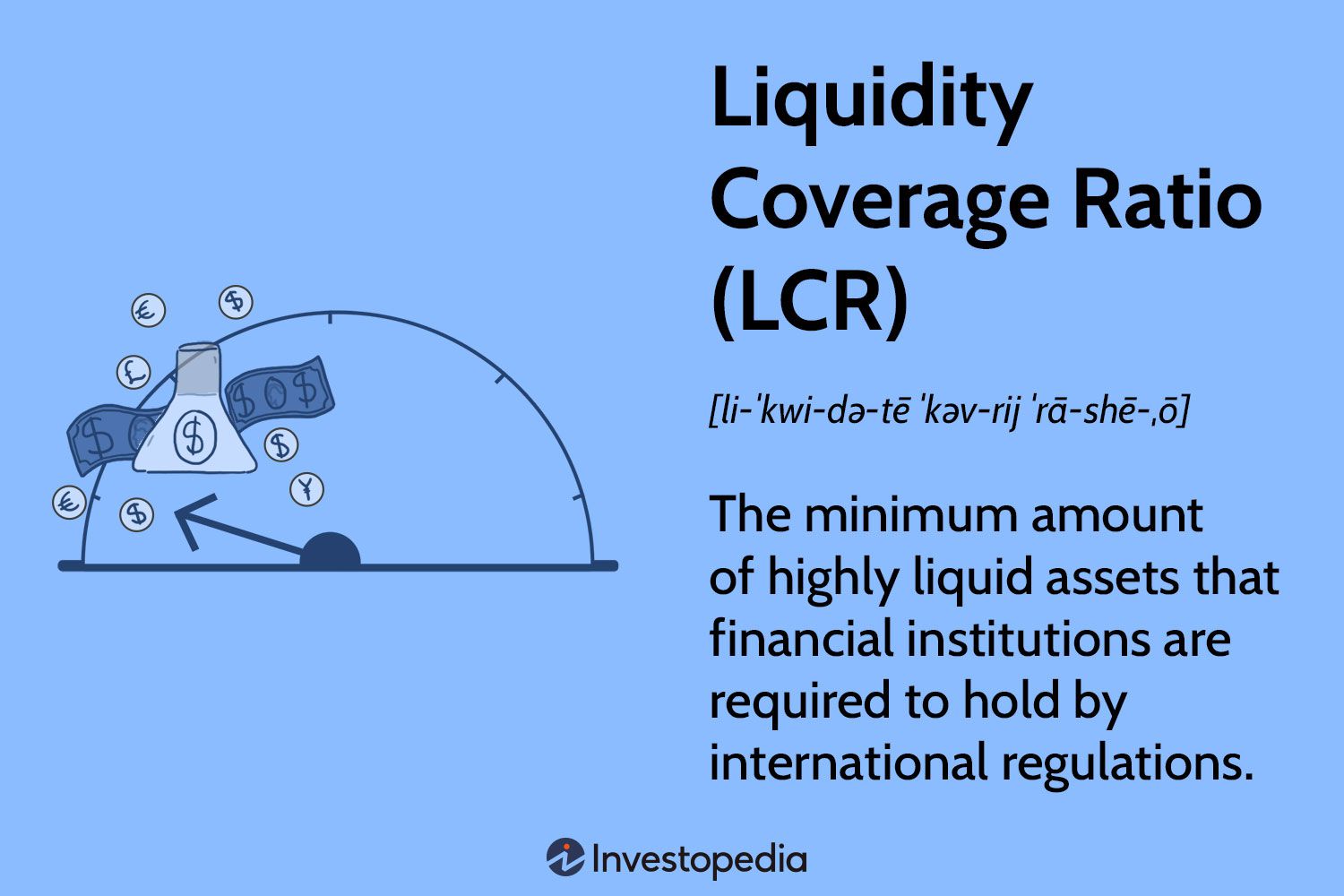What Is the Liquidity Coverage Ratio (LCR)?
The liquidity coverage ratio (LCR) refers to the proportion of highly liquid assets that financial institutions must hold to ensure that they can meet their short-term obligations and ride out any disruptions in the market. It is mandated by international banking agreements known as the Basel Accords.
Key Takeaways
- The liquidity coverage ratio (LCR) is a requirement under Basel III whereby banks are required to hold enough high-quality liquid assets to cover cash outflows for 30 days.
- The LCR aims to anticipate market-wide shocks and make sure that financial institutions are able to ride them out.
- We won’t know until the next major financial crisis if the LCR provides enough of a financial cushion.
Understanding the Liquidity Coverage Ratio (LCR)
The liquidity coverage ratio (LCR) is a product of the Basel Accords, a series of regulations developed by the Basel Committee on Banking Supervision (BCBS). The BCBS is a group of 45 representatives from major global financial centers. One of its roles is to set standards that will maintain the solvency of the worldwide banking system no matter what stresses the system encounters.
As part of that, banks are required to hold enough high-quality liquid assets to fund cash outflows for 30 days. High-quality liquid assets include only those that can be converted easily and quickly into cash. The three categories of liquid assets with decreasing levels of quality are level 1, level 2A, and level 2B.
Thirty days was chosen in the belief that in the event of a serious a financial crisis, governments and central banks, such as the Federal Reserve Bank in the U.S., would most likely step in to rescue and stabilize the financial system within that time frame. Having a 30-day cushion of cash would theoretically enable the banks to survive a bank run until that happened.
Under Basel III, level 1 assets are not discounted when calculating the LCR, while level 2A and level 2B assets have a 15% and a 25%–50% discount, respectively. Level 1 assets include Federal Reserve bank balances, foreign resources that can be withdrawn quickly, securities issued or guaranteed by specific sovereign entities, and U.S. government-issued or -guaranteed securities.
Level 2A assets include securities issued or guaranteed by specific multilateral development banks or sovereign entities, and securities issued by U.S. government-sponsored enterprises. Level 2B assets include publicly traded common stock and investment-grade corporate debt securities issued by nonfinancial sector corporations.
How to Calculate the LCR
Calculating LCR is as follows:
LCR=Total net cash flow amountHigh quality liquid asset amount (HQLA)
For example, let’s assume Bank ABC has high-quality liquid assets worth $55 million and $35 million in anticipated net cash flows over a 30-day stress period:
In this case, the bank’s LCR is $55 million / $35 million. That works out to 157%, which meets the requirement under Basel III.
Implementation of the LCR
The LCR was proposed in 2010, followed by revisions and final approval in 2014. Its implementation was then phased in, with the full 100% minimum not required until 2019.
In the United States, the 100% LCR rule applies only to banking institutions with more than $250 billion in total consolidated assets.
LCR vs. Other Liquidity Ratios
Liquidity ratios of various kinds are used not only in bank regulation but throughout the business and financial world, typically as a measure of a company’s ability to pay off its current debt obligations without raising external capital. Well-known examples include the current ratio, quick ratio, and operating cash flow ratio.
Limitations of the LCR
A limitation of the LCR is that it requires banks to hold more cash than they might otherwise and, as a consequence, lend out less money to businesses and individual consumers. One could argue that if banks issue fewer loans, it could lead to slower economic growth since companies often need access to debt in order to fund their operations and expand. Similarly, consumers would conceivably purchase fewer cars, appliances, and other products, which they often borrow money to pay for.
Another limitation is that we won’t know until the next major financial crisis if the LCR provides enough of a financial cushion for banks until other institutions come to their rescue.
What Are the Basel Accords?
The Basel Accords are a series of three sequential banking regulation agreements (Basel I, II, and III) set by the Basel Committee on Bank Supervision (BCBS). The BCBS is a group of 45 representatives from major global financial centers. The committee provides recommendations on banking and financial regulations—specifically concerning capital risk, market risk, and operational risk. The accords ensure that financial institutions have enough capital on account to absorb unexpected losses. The liquidity coverage ratio (LCR) is a chief takeaway from the Basel III Accord.
What Are Some Limitations of the LCR?
A limitation of the LCR is that it requires banks to hold more cash and might lead to fewer loans made to consumers and businesses, which could result in slower economic growth. From the banks’ perspective, having to keep more cash in reserve and make fewer loans can hamper profits.
What Is the LCR for a SIFI?
A systemically important financial institution (SIFI) is a bank, insurance company, or other financial institution that U.S. federal regulators determine would pose a serious risk to the economy if it were to collapse. Currently, these are defined as institutions that have more than $250 billion in assets. They are required to maintain a 100% LCR and also subject to other, more stringent regulatory requirements.
The Bottom Line
The liquidity coverage ratio (LCR) is a measure intended to force financial institutions to set aside enough highly liquid capital to get them through the early stages of a financial crisis. If successful, that could prevent the crisis from spreading and causing greater economic harm.
